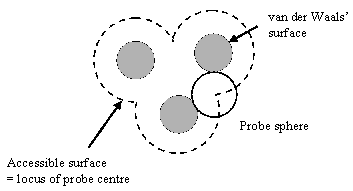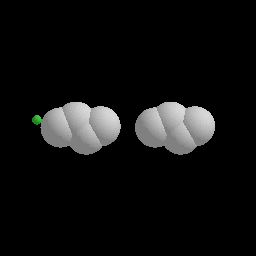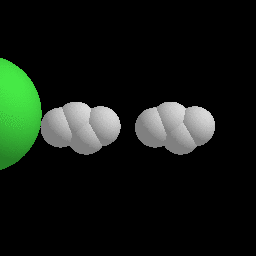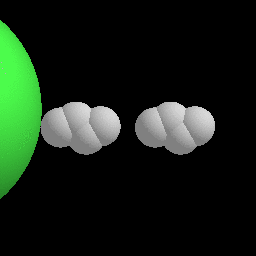Protein Surfaces
It can often be useful to visuzlize the surface of a protein and to calculate which amino acids are exposed on the surface and by how much.
van der Waals surface
The simplest type of surface is that defined by the van der Waals radii of the atoms.
View this structure (crambin, 1crn) using RasMol.
- From the RasMol menus, choose Display->Spacefill
You are now viewing the van der Waals surface of the protein.
As an alternative, you can view the van der Waals surface as a see-through 'dot' image overlaying the wireframe image:
- From the RasMol menus, choose Display->Sticks
- Now, in the RasMol command window, type:
dots on
You can now see the van der Waals surface as a set of dots with the thick wireframe image inside.
Solvent accessible surface
The solvent accessible surface is the surface described by rolling a probe sphere over the van der Waals surface and recording the set of points described by the centre of the sphere. The radius of the probe sphere is typically 1.4A to represent a water molecule.
You can also envisage this as the van der Waals surface of the same molecule where the radii of all the atoms has been increased by the specified probe size.
This is illustrated in this diagram taken from http://www.ccp4.ac.uk/newsletters/newsletter38/03_surfarea.html

You can see a 0.4A, 1.4A (water-sized), 5.0A and 10.0A probes rolling over some atoms in the following animations. Note how the small probe falls between the atoms while the larger probes glide over the surface and do not fit into the gaps between atoms.




If these do not animate, then swap to another page and then return to this page. If that doesn't work, use the right mouse button to reload/refresh this frame. If it still doesn't work, use the right mouse button to view only this frame and press the shift key while you click the reload/refresh button
Molecular surface
The molecular surface is the surface described by rolling a probe sphere over the van der Waals surface and recording the set of points described by the inner edge of the sphere.
This is illustrated in this diagram taken from http://www.ccp4.ac.uk/newsletters/newsletter38/03_surfarea.html
